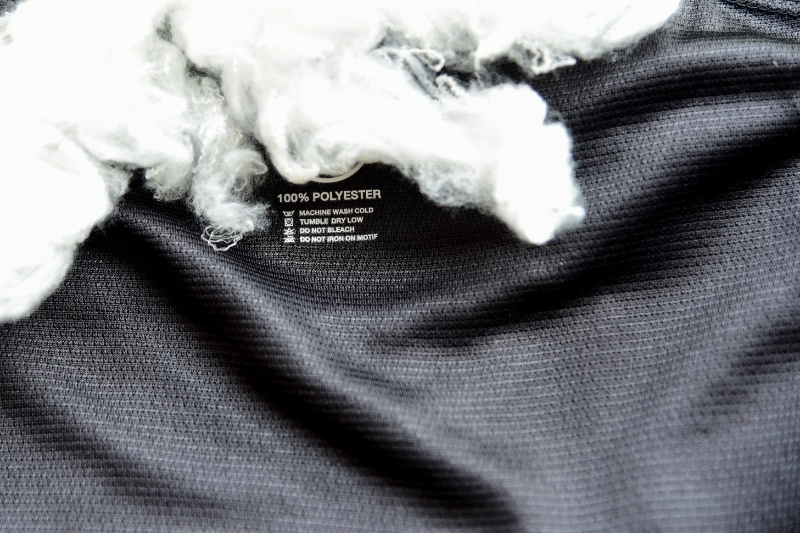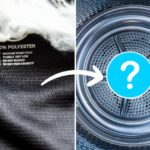Polyester is a synthetic fabric used for a variety of garments. It’s a popular choice for travel clothing, workwear, and garments that require minimal maintenance for one core reason: its resistance to wrinkles and creases compared to natural fibres like cotton or linen.
But what gives polyester these wrinkle-resistant properties? Does polyester wrinkle at all? And, if so, how can you keep polyester from wrinkling so that you don’t ever need to iron it again?
Keep reading for the answers to these three questions and more.
Is Polyester Prone to Wrinkles?
While polyester can develop some wrinkles, it tends to be more wrinkle-resistant and easier to maintain than many other fabrics.
Therefore, it’s safe to say that polyester is not prone to wrinkles. In fact, its fibres have several inherent properties that contribute to its crease-resistant nature, as explained here:
1. Polyester fibres are resilient

Polyester is considered a resilient fabric. This means it can bounce back to its original shape after being stretched or compressed, helping to prevent the material from wrinkling.
To understand how polyester is so resilient, we need to look at the structure of the material:
- Long polymer chains: Polyester is made from long chains of polymers (hence the name “polyester”), which are essentially repeating units of molecules. These polymers are tightly packed together, creating a strong and stable structure. This molecular arrangement allows the fabric to maintain its shape and resist wrinkling.
- High tensile strength: Polyester also fibres have high tensile strength because they’re made from long-chain molecules aligned linearly. This means they can withstand significant pulling force before breaking, helping the fabric recover from stretching and retain its original shape—in other words, no wrinkles!
2. The fibres are heat-set
Many polyester fabrics are heat-set during manufacturing. Heat-setting involves subjecting the polyester fabric to elevated temperatures (170°C to 210°C) while under tension.
This can be achieved using various methods, such as passing the fibres through a heated chamber or using heated rollers. The fibres are then cooled under tension to “lock in” the new molecular arrangement.
The heat-setting process helps stabilise the molecular structure of the fibres and sets them in a specific configuration. This improves their dimensional stability, resilience, and other characteristics, all of which minimise the formation of wrinkles.
3. Polyester isn’t absorbant
Finally, polyester is not inherently absorbent like natural fibres such as cotton or wool. This is because the molecules that make up the polyester fibres are hydrophobic, meaning it repels water and does not readily absorb moisture.
Low moisture absorbency reduces the likelihood of the fabric becoming distorted or wrinkled due to changes in humidity or moisture content.
This characteristic also has several other advantages, such as being fast-drying, more resistant to staining, and increased durability, making them suitable for sportswear, swimwear, and outdoor clothing.

What Causes Polyester to Wrinkle?
Polyester tends to perform better than natural fibres in terms of wrinkles (or lack of, should we say).
But despite its crease-resistant properties, it’s important to note that all fabrics – including polyester – can still wrinkle to some extent. This is especially true if they are subjected to a lot of stress, compression, or improper care.
Some of the main factors that contribute to wrinkling in polyester fabrics include:
- Creasing and folding: Just like any fabric, if polyester is creased or folded and left in that position for a prolonged period, wrinkles can develop. This is particularly true if the fabric is tightly compressed or folded in a way that puts stress on the fibres.
- Heat and pressure: High heat and pressure, such as from an iron or a clothes dryer, can cause polyester fibres to relax and lose their shape temporarily. If the fabric is not properly stretched or hung after exposure to heat, it can develop wrinkles.
- Improper laundering: Overloading the washing machine or dryer and using high heat settings can contribute to creasing in polyester fabrics. These cause the garments to become squashed at high temperatures, and the fibres “reset” in their bunched-up state.
- Drying method: Tumble drying polyester on high heat can cause the fibres to shrink or distort, resulting in wrinkles. Leaving your clothes in the dryer for too long can also result in overdrying and wrinkling. Air drying or using low-heat settings is gentler on the fabric.
- Improper handling: Rough handling of polyester garments, such as crumpling them into a ball, can lead to wrinkles. Leaving your clothes scrunched up in the bottom of a sports bag or thrown on a bedroom chair can also lead to creases forming.
How Do You Keep Polyester from Wrinkling?
Polyester is a popular fabric precisely because of its wrinkle-resistant properties. To make the most of these inherent characteristics, you must follow proper storage and laundry guidelines. Otherwise, your polyester garments might end up wrinkled after all.
Here are our top tips for laundering, drying, storing, and ironing polyester clothes to keep them free from wrinkles and creases:
1. Wash properly
- Follow the care instructions to ensure you’re washing and drying the fabric correctly.
- Use a gentle or delicate cycle when machine washing polyester.
- Avoid overloading the washing machine, as overcrowding can lead to increased wrinkling.
- Use a mild detergent to prevent damage to the polyester fibres.
2. Drying techniques
- Remove polyester garments from the dryer promptly to prevent wrinkling.
- Avoid over-drying your polyester clothes to stop wrinkling in the tumble dryer.
- Air dry or use a low heat setting when tumble drying to minimise heat-related wrinkles.
- Shake out garments before hanging or laying them flat to dry.
3. Storage considerations
- Hang polyester garments on hangers or fold them neatly after laundering.
- If hanging, use padded or wide hangers to distribute the weight and prevent shoulder puckering.
- Avoid hanging heavy items on top of hanging clothes, as this can cause wrinkles to form.
- Store polyester garments in a dry, well-ventilated area to prevent moisture-related wrinkles.
- When packing for travel, consider rolling polyester garments instead of folding them. Rolling can help reduce wrinkles and save space in your luggage.
4. Steam or iron
- Use a garment steamer to gently remove wrinkles from polyester fabrics. Hold the steamer a few inches away from the material and use a sweeping motion.
- If ironing, use a low to medium heat setting, and place a thin cloth or pressing cloth between the iron and the fabric to prevent direct contact. Test on a small, inconspicuous area first.
- Remove wrinkles without an iron or steamer by hanging the garment in a steamy bathroom.
5. Other considerations
- Look for polyester blends with other fibres, such as cotton or spandex. These blends can offer improved wrinkle resistance while retaining other desirable qualities.
- Handle polyester garments with care to prevent unnecessary creasing and wrinkles. Avoid crumpling or balling up the fabric.
- Some fabric sprays and treatments are designed to reduce wrinkles. Follow the instructions on the product carefully.
Remember that while these tips can help minimise wrinkles in polyester fabrics, no fabric is entirely wrinkle-proof.
Some wrinkles may still develop in the material, but these tips will help keep any creasing to a minimum.

What Other Fabrics Are Wrinkle-Resistant?
Polyester is the original crease-resistant fabric, but there are many other materials that aren’t prone to wrinkling.
Fill your wardrobe with clothes made from these materials, and – assuming proper care and laundering – you’ll never (or rarely) have to set up the iron and ironing board again.
- Tencel: Tencel, also known as lyocell, is a cellulose-based fabric made from sustainably sourced wood pulp. It has a smooth texture and excellent moisture-wicking properties, which contribute to its wrinkle resistance.
- Modal: Modal is another cellulose-based fabric derived from beech tree pulp. It is known for its softness, drape, and resistance to wrinkles, making it a popular choice for casual and dressy clothing.
- Microfibre: Microfibre fabrics are made from very fine synthetic fibres, often a blend of polyester and polyamide. They are lightweight, breathable, and inherently crease-resistant, making them ideal for travel and activewear.
- Polyester blends: Fabrics that blend polyester with other fibres, such as cotton or wool, can offer improved wrinkle resistance while retaining the benefits of the other fibres, such as breathability or warmth.
- Nylon: Like polyester, nylon is a synthetic fabric that resists wrinkles and retains its shape well. However, it tends to be stronger, stretchier, and more weather resistant than polyester. It’s commonly used in sportswear, activewear, and accessories.
- Stretch cotton blends: Fabrics that blend cotton with a small amount of spandex or elastane for stretchiness tend to be more wrinkle-resistant than pure cotton due to the added elasticity that helps the fabric recover its shape.
Keep in mind that while these fabrics are generally considered crease-resistant, factors like care, handling, and specific garment construction can still influence how wrinkled they become.

Hannah has a passion for cleaning. She worked her way around Australia by cleaning hostels in exchange for free accommodation and used her cleaning skills to bag a job as a chalet host for a luxury ski company in France.




